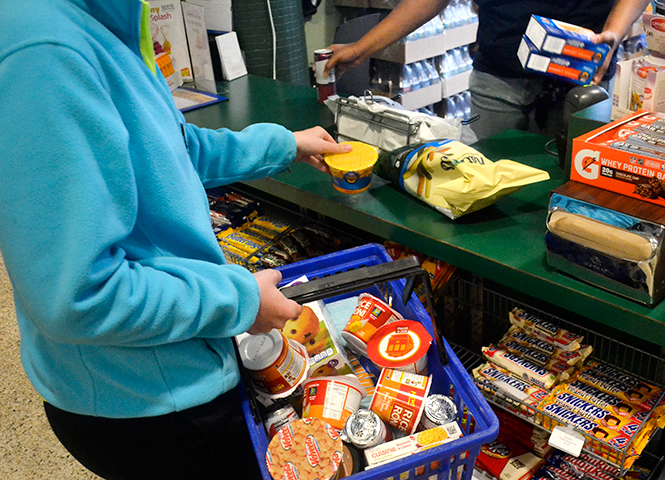Students struggle to max out meal plans
Freshman early childhood education major Emily Dame buys a full basket of food at Prentice Munchies using her meal plan, Monday, April 28, 2014.
April 28, 2014
Melanie Sugalski has an outstanding balance of $900 left on her meal plan.
Sugalski, a sophomore visual communication design major, said she plans on spending as much as possible on buying groceries for her family.
“I had the lite plan, but I tend to go home on the weekends, so I don’t use up a lot of money,” Sugalski said.
Sugalski is one of many Kent State students who are trying to spend the rest of their meal plan before the semester ends. Last year, 5,688 students who subscribed to the lite, basic, premier and premier plus meal plans combined left $161,000 unspent at the end of the 2013 spring semester — a $34,000 increase from the previous year.
Richard Roldan, resident district manager of dining services, said students are responsible for spending their meal plan by the end of the semester. He said the students pay a lump sum at the beginning of the year for a specific meal plan they choose, which is factored into the dining services budget.
The money students do not spend is their loss, but Roldan said Dining Services tries to prevent the shock of students having high balances.
“We try to guide everybody, and I personally reach out to the folks who have high balances and try to find out why aren’t you using the meal plan,” Roldan said. “I talk to the students directly because they are adults, and they are here, and we try to work with them to make understand you are paying for this service so use it.”
Students can choose from plans that range from the $1,685 lite plan to the premier plus plan worth $2,535. Both the premier and premier plus — the most expensive meal plan — can carry over from year to year if the student chooses it again.
According to meal plan data from Dining Services, the premier plus plan has had the lowest carry over at the end of spring semester since 2008. From 2008 to 2013, 880 more students subscribed to the lite meal plans — a jump from 1,034 to 1,914 — and have left $30,000 more unspent on their Flashcards.
The basic meal plan, which has stayed the most popular since 2008, has nearly doubled in the amount students do not spend in a five-year time span.
Maegan Kristyak, a senior sports administration reporter and student worker at Prentice Munchies Market, said she has noticed the increase of students buying groceries within the last weeks of the semester.
“A lot of people are using up their meal plan,” Kristyak said. “The highest I’ve seen is $400, just recently they have spent 100 bucks like it was nothing.”
As enrollment and the cost of food has increased, so have the cost of meal plans and the amount of money left over at the end of the semester, Roldan said.
“Price of the meal plan has gone up and so has costs for the economy, so some of our pricing has increased,” he said.
Kenyatta Reed, freshman sociology major, said she has about $880 on her meal plan. Reed has the premiere plan, which starts at $2,160 and can carry over from semester to semester and year to year.
“My mom wanted me to be over prepared,” Reed said. “I am actually helping out people who need meal plan [money]. I just don’t want to waste the rest of the money on there.”
In 2008, the average student had $16.08 at the end of spring semester; in 2013, the average student left $28.33 unspent.
Meghan Wallich, sophomore fashion merchandising major, said she is tired of on-campus food, which accounts for her high balance on her meal plan.
“I have $670,” Wallich said. “I eat off campus a lot. My friends use me for my meal plan, and in return, they give me cigarettes. If I still have money left over, I’ll buy a bunch of water and take it home”
Ashley Atherton, sophomore history major, currently has the basic plan but said she is going to switch the lite plan next school year because she can’t use the money.
“Last time I checked, [I have] 470 something,” Atherton said. “I think it’s because I work off campus, and I eat lunch off campus, so I usually just take a cereal bar or something.”
Atherton said she is going grocery shopping for her apartment to spend the rest of her meal plan.
While Roldan and Dining Services recognize that a lot of students have high balances on their meal plans at the end of spring semester, they rely on the student to use the money they paid for.
“We provide everything for you, and you’re paying the money for it,” Roldan said.” “Use it. Come in. Eat in our facilities. That’s the only thing I can tell and continue to tell the families and their parents.”
Contact Breyanna Tripp at [email protected].












